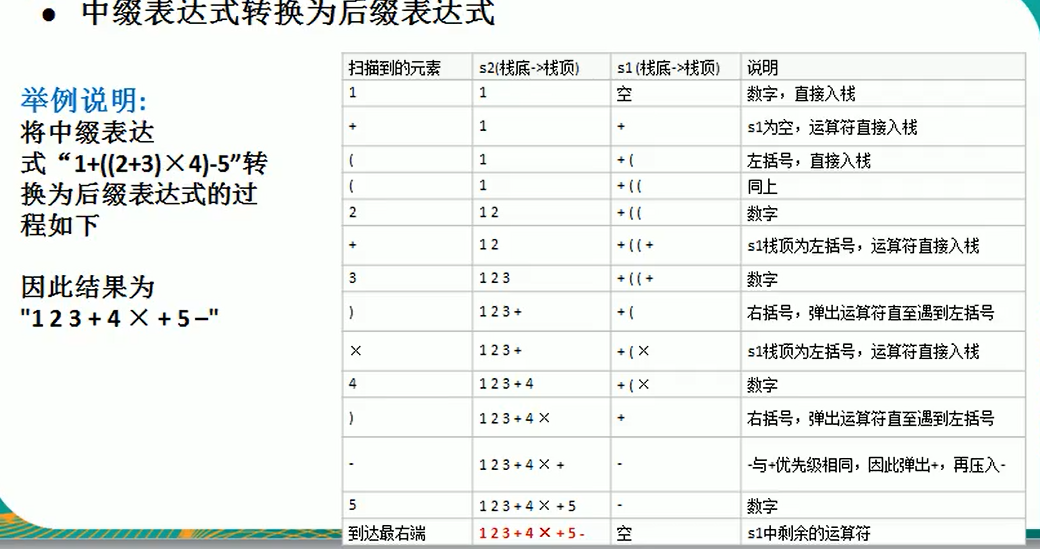后缀表达式适合于计算式运算,但是人却不太容易写出来,尤其是表达式很长的情况下,因此在开发中,我们需要将中缀表达式转成后缀表达式。
具体步骤如下:
1)初始化两个栈:运算符栈s1和储存中间结果得栈s2;
2)从左到右扫描中缀表达式;
3)运到操作符时,将其压入s2;
4)遇到运算符时,比较其s1栈顶运算符的优先级:
(1)如果s1为空,或者栈顶运算符为左括号“(”,则直接将次运算符入栈;
(2)否则,若优先级比栈顶运算符的高,也将运算符压入s1;
(3)否则,将s1栈顶的运算符弹出并且压入到s2中,再次转到(4.1)与s1中新的栈运算符相比较
5.遇到括号时:
(1)如果是左括号“(”,则直接压入s1;
(2)如果是右括号“)”,则依次弹出s1栈顶的运算符,并压入s2,直到遇到左括号位置,,此时将这一对括号丢弃
6.重复步骤2-5,直到表达式的最右边
7。将s1中剩余的运算符依次弹出并压入s2
8.依次弹出s2中元素并输出,结果得逆序即为中缀表达式对应的后缀表达式
思路:

逆波兰计算器完整版:
public class PolandNotation { public static void main(String[] args) { //完成将一个中缀表达式转成后缀表达式的功能 //说明 //1. 1+((2+3)×4)-5 => 转成 1 2 3 + 4 × + 5 – //2. 因为直接对str 进行操作,不方便,因此 先将 "1+((2+3)×4)-5" =》 中缀的表达式对应的List // 即 "1+((2+3)×4)-5" => ArrayList [1,+,(,(,2,+,3,),*,4,),-,5] //3. 将得到的中缀表达式对应的List => 后缀表达式对应的List // 即 ArrayList [1,+,(,(,2,+,3,),*,4,),-,5] =》 ArrayList [1,2,3,+,4,*,+,5,–] String expression = "1+((2+3)*4)-5";//注意表达式 List<String> infixExpressionList = toInfixExpressionList(expression); System.out.println("中缀表达式对应的List=" + infixExpressionList); // ArrayList [1,+,(,(,2,+,3,),*,4,),-,5] List<String> suffixExpreesionList = parseSuffixExpreesionList(infixExpressionList); System.out.println("后缀表达式对应的List" + suffixExpreesionList); //ArrayList [1,2,3,+,4,*,+,5,–] System.out.printf("expression=%d", calculate(suffixExpreesionList)); // ? /* //先定义给逆波兰表达式 //(30+4)×5-6 => 30 4 + 5 × 6 - => 164 // 4 * 5 - 8 + 60 + 8 / 2 => 4 5 * 8 - 60 + 8 2 / + //测试 //说明为了方便,逆波兰表达式 的数字和符号使用空格隔开 //String suffixExpression = "30 4 + 5 * 6 -"; String suffixExpression = "4 5 * 8 - 60 + 8 2 / +"; // 76 //思路 //1. 先将 "3 4 + 5 × 6 - " => 放到ArrayList中 //2. 将 ArrayList 传递给一个方法,遍历 ArrayList 配合栈 完成计算 List<String> list = getListString(suffixExpression); System.out.println("rpnList=" + list); int res = calculate(list); System.out.println("计算的结果是=" + res); */ } //即 ArrayList [1,+,(,(,2,+,3,),*,4,),-,5] =》 ArrayList [1,2,3,+,4,*,+,5,–] //方法:将得到的中缀表达式对应的List => 后缀表达式对应的List public static List<String> parseSuffixExpreesionList(List<String> ls) { //定义两个栈 Stack<String> s1 = new Stack<String>(); // 符号栈 //说明:因为s2 这个栈,在整个转换过程中,没有pop操作,而且后面我们还需要逆序输出 //因此比较麻烦,这里我们就不用 Stack<String> 直接使用 List<String> s2 //Stack<String> s2 = new Stack<String>(); // 储存中间结果的栈s2 List<String> s2 = new ArrayList<String>(); // 储存中间结果的Lists2 //遍历ls for(String item: ls) { //如果是一个数,加入s2 if(item.matches("\d+")) { s2.add(item); } else if (item.equals("(")) { s1.push(item); } else if (item.equals(")")) { //如果是右括号“)”,则依次弹出s1栈顶的运算符,并压入s2,直到遇到左括号为止,此时将这一对括号丢弃 while(!s1.peek().equals("(")) { s2.add(s1.pop()); } s1.pop();//!!! 将 ( 弹出 s1栈, 消除小括号 } else { //当item的优先级小于等于s1栈顶运算符, 将s1栈顶的运算符弹出并加入到s2中,再次转到(4.1)与s1中新的栈顶运算符相比较 //问题:我们缺少一个比较优先级高低的方法 while(s1.size() != 0 && Operation.getValue(s1.peek()) >= Operation.getValue(item) ) { s2.add(s1.pop()); } //还需要将item压入栈 s1.push(item); } } //将s1中剩余的运算符依次弹出并加入s2 while(s1.size() != 0) { s2.add(s1.pop()); } return s2; //注意因为是存放到List, 因此按顺序输出就是对应的后缀表达式对应的List } //方法:将 中缀表达式转成对应的List // s="1+((2+3)×4)-5"; public static List<String> toInfixExpressionList(String s) { //定义一个List,存放中缀表达式 对应的内容 List<String> ls = new ArrayList<String>(); int i = 0; //这时是一个指针,用于遍历 中缀表达式字符串 String str; // 对多位数的拼接 char c; // 每遍历到一个字符,就放入到c do { //如果c是一个非数字,我需要加入到ls if((c=s.charAt(i)) < 48 || (c=s.charAt(i)) > 57) { ls.add("" + c); i++; //i需要后移 } else { //如果是一个数,需要考虑多位数 str = ""; //先将str 置成"" '0'[48]->'9'[57] while(i < s.length() && (c=s.charAt(i)) >= 48 && (c=s.charAt(i)) <= 57) { str += c;//拼接 i++; } ls.add(str); } }while(i < s.length()); return ls;//返回 } //将一个逆波兰表达式, 依次将数据和运算符 放入到 ArrayList中 public static List<String> getListString(String suffixExpression) { //将 suffixExpression 分割 String[] split = suffixExpression.split(" "); List<String> list = new ArrayList<String>(); for(String ele: split) { list.add(ele); } return list; } //完成对逆波兰表达式的运算 /* * 1)从左至右扫描,将3和4压入堆栈; 2)遇到+运算符,因此弹出4和3(4为栈顶元素,3为次顶元素),计算出3+4的值,得7,再将7入栈; 3)将5入栈; 4)接下来是×运算符,因此弹出5和7,计算出7×5=35,将35入栈; 5)将6入栈; 6)最后是-运算符,计算出35-6的值,即29,由此得出最终结果 */ public static int calculate(List<String> ls) { // 创建给栈, 只需要一个栈即可 Stack<String> stack = new Stack<String>(); // 遍历 ls for (String item : ls) { // 这里使用正则表达式来取出数 if (item.matches("\d+")) { // 匹配的是多位数 // 入栈 stack.push(item); } else { // pop出两个数,并运算, 再入栈 int num2 = Integer.parseInt(stack.pop()); int num1 = Integer.parseInt(stack.pop()); int res = 0; if (item.equals("+")) { res = num1 + num2; } else if (item.equals("-")) { res = num1 - num2; } else if (item.equals("*")) { res = num1 * num2; } else if (item.equals("/")) { res = num1 / num2; } else { throw new RuntimeException("运算符有误"); } //把res 入栈 stack.push("" + res); } } //最后留在stack中的数据是运算结果 return Integer.parseInt(stack.pop()); } } //编写一个类 Operation 可以返回一个运算符 对应的优先级 class Operation { private static int ADD = 1; private static int SUB = 1; private static int MUL = 2; private static int DIV = 2; //写一个方法,返回对应的优先级数字 public static int getValue(String operation) { int result = 0; switch (operation) { case "+": result = ADD; break; case "-": result = SUB; break; case "*": result = MUL; break; case "/": result = DIV; break; default: System.out.println("不存在该运算符" + operation); break; } return result; } }